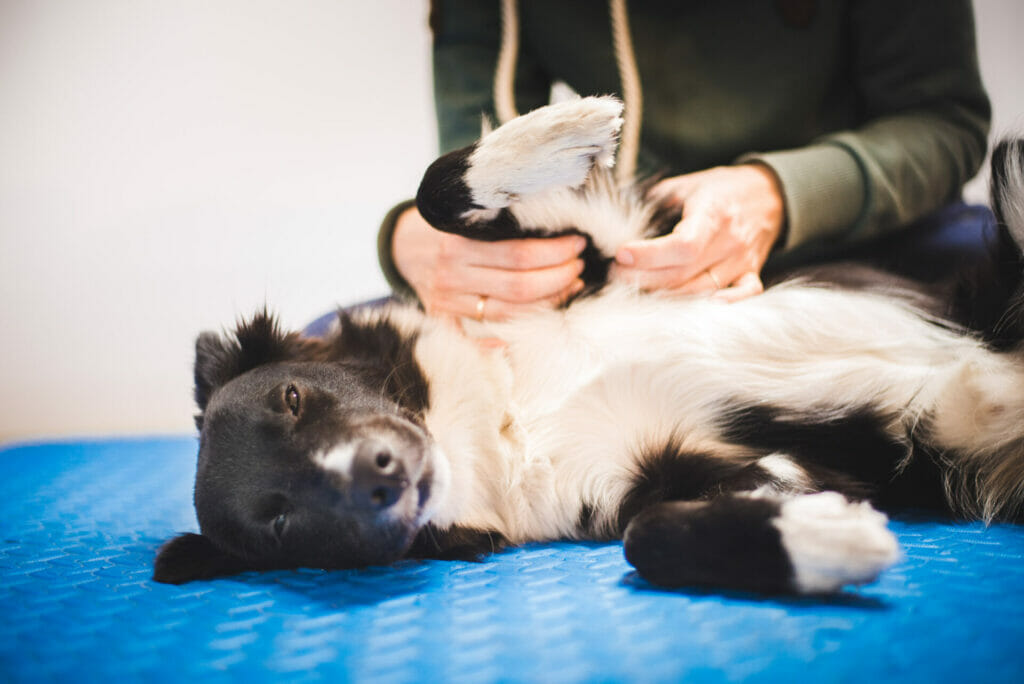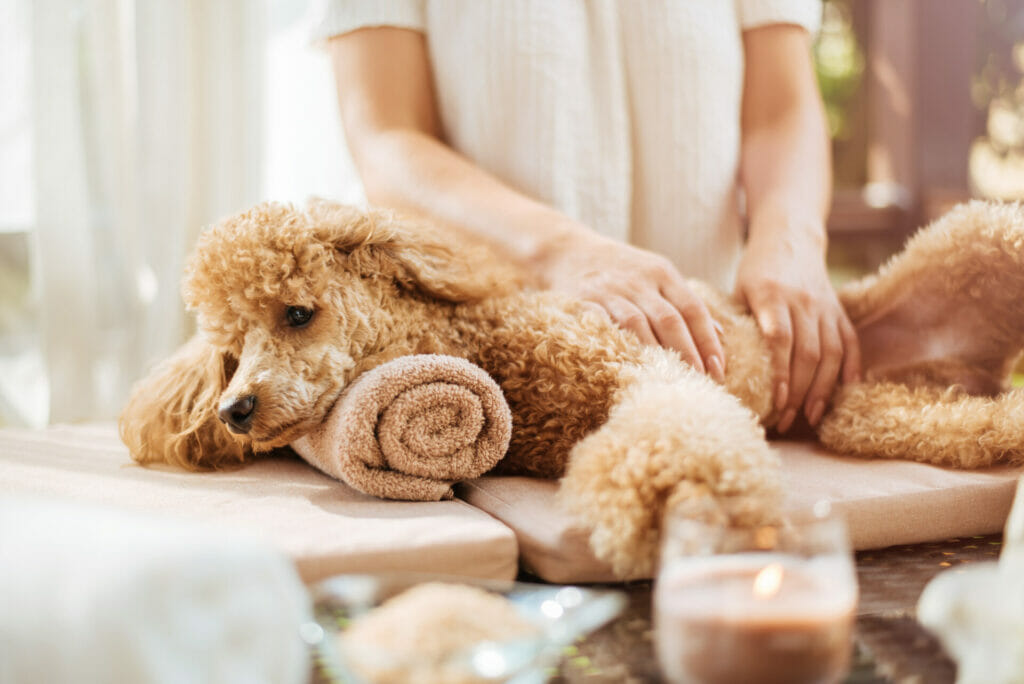Not only is a canine massage enjoyable for our furry friends but it’s also proven to have many health benefits for them. You can perform a basic canine massage at home, and it only takes a few minutes. Plus, it’s a wonderful way to build and strengthen the bond you share with your canine companion.
The Benefits of Dog Massage

1. It Reduces Stress and Anxiety
Massage is proven to reduce stress and anxiety, which is a huge plus for any dog and especially helpful for pups that are easily stressed or worried. Like with humans who experience anxiety, anxious dogs can benefit from a consistent, reassuring routine. Incorporating massage into your dog’s daily routine – perhaps as a nighttime ritual or a morning routine – can provide a comforting form of relaxation.
Gentle hands-on massage can effectively reduce everyday anxiety in our pups, including during stressful situations such as a thunderstorm or fireworks. Dogs really enjoy a good massage, as the physical contact can help calm them when anxious.
2. It Decreases Pain
Beyond the obvious benefits of relieving muscle tension, canine massage therapy can be a powerful tool for realigning the spine and body, which is great for your dog’s health. Gentle rubbing and kneading on your dog can increase circulation to a sore area or joint. The gentle pressure of your hands causes tissues to contract and increases local blood flow. Take caution not to press too hard, and stop if your pet flinches, moves away, nips, or growls.
The act of massaging a dog stimulates the release of endorphins, which helps to alleviate pain. If your dog has spent a long day running, playing, or even swimming, this exertion can sometimes lead to soreness and stiffness in the joints and muscles. Massage will help to relax those muscles and release tense areas.
Dogs with conditions like arthritis will also appreciate massage for this reason. If your dog is recovering from a painful injury, you can ask your veterinarian if there are any specific massage techniques you can perform at home to relieve pain.
3. It Assists in the Recovery Process
Canine massage can be a wonderful form of therapy for animals who are rehabilitating from an injury or surgery. Your vet may be able to show you specific massage techniques to help your fur baby along in the recovery process. Plus, it’s not only the injured area that can benefit from healing touch, so it’s helpful to take a holistic approach to massage in recovering dogs.
For example, to compensate for an injured leg, over time a dog will have put excessive stress and strain on many other muscle groups throughout the body. Therefore, their whole body can benefit from an efficient massage during recovery. This can really help your dog tremendously.
4. It Improves Circulation and Lymphatic Flow
Dog massage is great for increasing a dog’s circulation and lymphatic flow, which benefits their entire body. Good circulation ensures your pup gets a healthy supply of blood, oxygen, and nutrients to their brain and other organs, and keeps their skin and coat healthy.
Improving the flow of the lymph fluid in the lymphatic system helps carry metabolic waste away from their muscles and internal organs. Your dog will have a better chance of avoiding certain health conditions like hypertension (high blood pressure) and edema (an excess of watery fluid collecting in the cavities or tissues of the body). There are so many important factors regarding your dog’s health.
5. It Helps You Identify Potential Health Issues
The more you get familiar with your dog’s skin and hair, the easier it will be to notice if something feels different or wrong. Another added benefit of regular canine massage is that you become familiar with your dog’s body and can better recognize what is normal and not normal. This allows you to identify any trouble spots to bring to your veterinarian’s attention for further investigation.
As you massage your pup, look for any unusual swelling or lumps, changes in surface temperature, sensitivity to touch, or quality of skin or hair. Early detection is one way that regular massage can add to the length and quality of your dog’s life. Dog massage is also vital to strengthening your pet’s immune system.
How to Massage Your Dog
Step 1: Slowly start dog massage therapy
Pick a quiet part of your living space for the massage to help your dog feel calm and secure. Do not try to start the massage if your pet is overly fearful or showing resistance. First, softly stroke the area of interest. Use flat palms to press against the skin lightly. Move your hands slowly using long, sweeping motions and in circular motions.
While massaging, take note of any swelling, increased sensitivity, and pain. Stop if it seems to hurt your dog in any way.
Step 2: Work on the whole body
Using the technique described above, start from the head and neck, and work down the body, gently increasing pressure if your dog seems to enjoy the massage therapy. Work in circular motions and sweeping motions. Do not press straight down on bones or joints. This can hurt them. Avoid all areas where your dog doesn’t like to be touched.
Step 3: Focus on the base of the skull & tail
A gentle massage at the base of the skull and tail can stimulate relaxation. Remember to make the experience enjoyable for them, and be sure to stop if your dog recoils, cries out, yelps, or seems to be in pain.
Things to Keep in Mind
The main thing to remember when massaging your dog at home is that you want to use gentle motions and techniques to ensure they’re comfortable throughout the entire process. While some humans may enjoy deep tissue massage, with dogs, it’s best to use light pressure and avoid anything fast, hard, or abrupt to prevent any adverse effects. Dog massage should be done with more caution, and be sure to give them plenty of treats as a reward.
Three massage techniques that are simple enough for you to do at home while still providing your dog with the wonderful health benefits canine massage has to offer are outlined here:
- Effleurage – Long, soothing strokes are used to begin and end the dog massage. This technique helps dogs relax, warms up the underlying tissues, and encourages blood flow throughout the body.
- Petrissage – Kneading or rolling motions that increase blood flow and lymphatic drainage and stimulate the removal of any toxins that may be trapped in the tissues of dogs.
- Compression – This is done by gently pressing the muscle against the bone to help spread muscle fibers and increase circulation. Applying two hands on opposite sides of the limbs, not pressing very hard at all.
Depending on the age and mobility of your dog, regular massages and treatments acclimate them to the treatment protocol, loosen the fascia and muscles, and relieve muscle tension and pain. Semi-regular “top-up” massage treatments can maintain these benefits.
Animal massage not only provides numerous health and therapeutic benefits, but it also makes your dog feel good! Massage can increase the amount of quality time you spend with your dog. Start pampering your pup with their first canine massage, and you will have a happier, healthier, and more balanced canine companion on your hands in no time!
Conclusion:
Through direct work on a dog’s soft tissues, canine massages can improve blood flow, alleviate stress, reduce pain, discomfort, relax tight and sore muscles, and help heal sprains, strains, and joint issues. In addition, many believe it also strengthens the immune system, improves digestion, and lowers blood pressure. Massage definitely strengthens the bond between humans and their dogs.




















